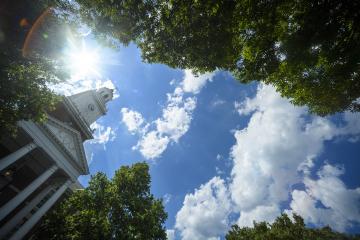A team of undergraduate students in the Whiting School of Engineering's Center for Leadership Education's Multidisciplinary Engineering Design course is contributing to the trend of retrofitting dams to generate power by competing in the Hydropower Collegiate Competition on Monday, April 29, in Des Moines, Iowa.
Part of the U.S. Department of Energy's American-Made program dedicated to increasing clean energy, the event challenges teams to identify an existing dam that is well-suited for conversion, develop a design that effectively retrofits the dam for hydropower production, and create programming that fosters community investment.
Hopkins' team is one of 12 selected to take part in the challenge, which offers the first- through third-place winners the opportunity to split a $25,000 prize. The students will also present their project at the Whiting School's annual Design Day on May 1—the same day the students will learn where they have placed in the competition.
The Hopkins team selected Liberty Dam, northwest of Baltimore, as their conversion site based on the low environmental impact of the conversion and the dam's height, which enables it to produce sufficient power.
Grace Mazur, a senior majoring in environmental engineering, said that while the dam offered many attractive opportunities for conversion, it also posed challenges.

Image caption: Visit to the Markland Dam on the Ohio River near Cincinnati. From left: Grace Mazur, course TA Trifeena James, and Alissa Burkholder Murphy
"We discovered that converting nonpowered dams to produce power can be really disruptive if you're using the traditional approach of bringing the water through the dam, which could involve draining the reservoir or taking apart part of the dam. Liberty Dam is about 70 years old, so we didn't want to design anything that would compromise the structure," she said.
They identified Liberty's advanced age as an opportunity to develop a modular solution that does not alter the dam's current infrastructure. Once selected to compete, the team was awarded $5,000 toward the development of its design and, after midyear reporting, another $10,000 to build a prototype and travel to the competition.
After researching existing designs, the students realized that they could design a more efficient and less disruptive alternative to large turbine-based approaches that maneuver over the top of dams to start a siphon of water. The team landed on an energy-saving dual-siphon system that uses a small pump and siphon to kickstart a larger siphon, carrying water over the dam and into a turbine. Placing the turbine at the end of the siphoned flow also makes the design more fish-friendly—a screen can prevent fish from entering their system.
Jenna Halpin, team member and senior civil engineering major, said that the benefit of this design lies in its modularity.
"It can actually be adapted very, very easily to fit almost any dam that exists currently, and what's really special is that we are not messing with the structural integrity of the dam, so no matter how old the dam is, as long as it has an appropriate reservoir, we can generate power," Halpin said.
Mazur found the competition's focus on sustainability and community appealing.
"I liked that the competition had a community element to it, thinking about how these engineering decisions affect communities and about how to get communities involved in that decision process. I also liked how the project focused on how we can use infrastructure that's already available instead of creating new things to generate energy," she said.
To generate community investment, the team focused on K-12 education in Baltimore City, developing five educational modules as well as in March hosting two pop-up events at Lake Roland featuring a homemade water wheel and activities for children.
"The kids are excited to learn about this stuff," Halpin said. "They were playing on the playground, with a beautiful dam nearby, and came over to our pop-up to ask about our project. We got to see their eyes light up when they learned that water can actually power things. It was really special to see the dots connect for them."
According to Alissa Burkholder Murphy, senior lecturer in the CLE and director of the Multidisciplinary Engineering Design Program, the team worked so well by leveraging each member's expertise.
"Environmental engineer Grace Mazur designed a green infrastructure bypass channel for their dam site, while Erin Lee, a chemical and biomolecular engineering major, conducted a system-wide risk assessment, and mechanical engineer Jason Zhong crunched flow rate numbers. And all teammates stepped outside their disciplines to learn computer-aided design and manufacturing methodologies from biophysics major Seth Jayawardane. That kind of teamwork is impressive," she said.
For more Design Day stories, visit the Whiting School's newsroom.
Posted in Science+Technology
Tagged energy, design days, whiting school









